Do you like making and playing with ooey-gooey slime? Do you want to learn more about slime, including some really cool recipes for slime? Then keep reading!
We have two really cool slime books in our collection that are basically cookbooks full of recipes for slime. Click on the title or the cover to find the book in the library catalog and place a hold on it. NOTE: Even though I use the term recipe, the slime I will be writing about today is NOT EDIBLE.
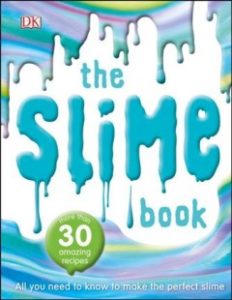
The Slime Book from DK Publishing
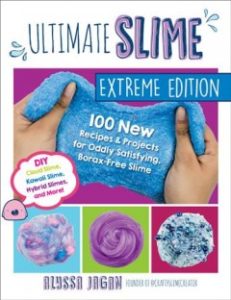
Ultimate Slime by Alyssa Jagan
I noticed pretty quickly that most recipes in The Slime Book call for a saline solution (contact lens solution) and most recipes in Ultimate Slime call for foaming hand soap. What if you don’t have either of those ingredients? Alyssa Jagan lists three different activators to use in her basic slime recipes: liquid laundry detergent, liquid starch (such as Sta-Flo) or baking soda mixed with contact lens solution.
I wondered if I could take the Fluffy Slime recipe from The Slime Book and use of the activators Jagan lists.
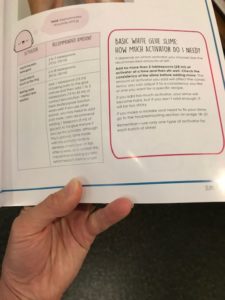
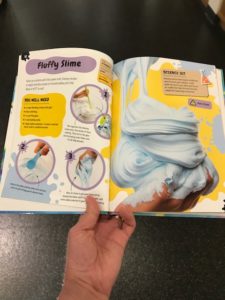
This is the Fluffy Slime recipe from The Slime Book, cut in half, with liquid starch substituted for the baking soda and saline solution:
Spread some old paper or plastic sheeting over your work surface for easier clean-up.
- 1 cup shaving cream
- 1 to 3 drops food coloring
- 2 Tablespoons PVA glue (the kind referred to as white glue or school glue)
- 3 Tablespoons liquid starch (used for laundry or crafts)
I put all the measured ingredients in a gallon-size plastic bag, zipped it closed (leaving as little air inside the bag as possible) and started mushing the ingredients until they seemed to be coming together.
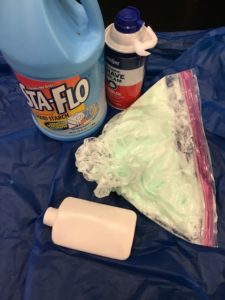
The clump of marshmallowy slime I ended up with stuck to my fingers a bit, but the photo in the book shows the slime sticking to somebody’s fingers, too, so it’s probably about the same results you would get from using contact lens solution and baking soda.
Next, I tried using 3 tablespoons of liquid laundry detergent in place of the liquid starch. This didn’t work at all! Jagan says in her book that to work, the laundry detergent has to contain “boric acid or a borate ion, such as Tide Free and Gentle.” I guess the brand I used did not contain this.
Note: Contact lens solution works as a slime activator because it contains boric acid or another chemical (sodium borate, buffered saline) that works the same way. I don’t think a simple homemade salt solution would work. Older recipes for slime just call for borax, which you sometimes see for sale next to the laundry detergent. Since borax in a powder form can irritate a person’s eyes or breathing, most recipes aimed at children avoid that chemical.
If you are out of glue, I found a recipe for PVA glue made with water, flour and sugar. Please note, the directions call for boiling water and cooking the ingredients on a stovetop, so children should have either help or supervision from an adult.
PVA stands for Polyvinyl Acetate. Jagan’s three basic recipes (which you use as a base for the more complicated recipes in her book) use different kinds of glue: white school glue, thicker white glue (she suggests Elmer’s Glue-All, but I think Aleene’s Tacky Glue would also fall into this category) and clear glue. Apparently, they are all Polyvinyl Acetate. You just mix the thick glue with different amounts of activator because the glue is thicker (or mix clear glue with different kinds of ingredients to keep the mixture clear).
Both The Slime Book and Ultimate Slime have suggestions for things to mix into your slime (beads, glitter, sand) to give it an interesting look or texture. Here is my finished product with a few dashes of silver glitter and some pom-poms:
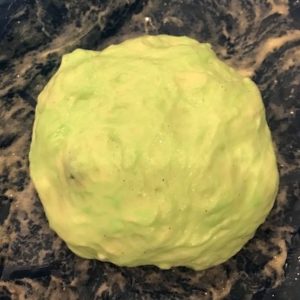
If you want to explore more, Ultimate Slime has lots of ideas for fine-tuning your slime recipe, such as what to add to prevent slime from getting hard on the top and getting creative (hybrid slimes made from two or more recipes mixed together for a new texture). The Slime Book tends to provide specific instructions that will each give one specific result, but they have some recipes with unusual ingredients (peel-off face masks, gelatin, sticky tack) and a section of edible slimes (mostly involving heat and candy with powdered sugar and cornstarch).
If you would prefer an eBook, Ultimate Slime and many other slime books are available from hoopla. You might also try one of these titles available through Axis 360:
- Recipes for Play: Creative Activities For Small Hands And Big Imaginations by Rachel Sumner and Ruth Mitchener
- Weird Science: 40 Strange-acting, Bizarre-looking, And Barely Believable Activities For Kids by Jim Wiese; illustrations by Ed Shems
You can also find instructions for galaxy slime on Creativebug, one of our newer online resources that has craft instruction videos for children and adults.
